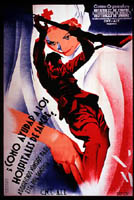 |
¿Como ayudar a los hospitales de sangre? ...
[How can you help the blood banks? Buy a raffle ticket and take part in this charitable event.]. . Comisión Organizadora Hospitales de Sangre y Guarderias de Niños del Sindicato Unico Regional de Peritos y Tecnicos Industriales, C.N.T.-A.I.T. Lithograph, 4 colors; 153 x 104 cm.
|
|
In the foreground of the poster, a soldier, bathed in red in order to highlight his revolutionary character, appears to be falling in battle. His legs intersect at the bottom of the poster with two fingers from a hand extended from the left. Behind these figures, there is the image of a Red Cross nurse. The general color scheme of the image is red, white, and blue. These images and color scheme formed a template, of sorts, on to which were put a range of messages to garner support for the aid organizations, Hospitales de Sangre and Guarderias del Niño. The text asks viewers to purchase a raffle ticket. Such raffles were a strategy to raise money for aid organizations that provided social services like medical care for the wounded and social support for children.
This poster was probably printed in 1936 at the outset of the civil war in Spain. In 1937, the Republican government placed several of its semi-public relief agencies under the management of its Ministry of Public Education and Health. Little is known about the Hospitales de Sangre or the Guarderias del Niño. One source seems to indicate that these organizations were associated with relief efforts organized by international relief organizations such as the Socorro Rojo Internacional (SRI). As a contemporary account of a relief worker in Spain attests, the structural and administrative interface of international relief organizations and those of the government or the government itself could be, at times, quite difficult to coordinate. This difficulty was especially prevalent in Nationalist Spain, especially towards the end of the conflict when it victory of Nationalist forces seemed more probable. Throughout the war, the Nationalist government had been held accountable by the Burgos Agreement, which stipulated, among other things, that the Nationalist government would not export food while receiving food aid at the same time.
The artist of the poster is unknown.
|




